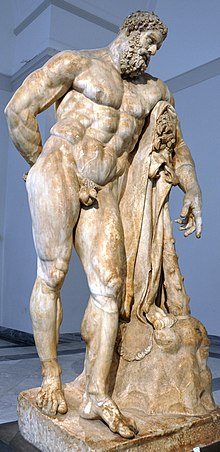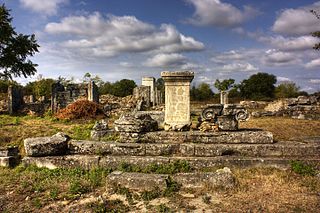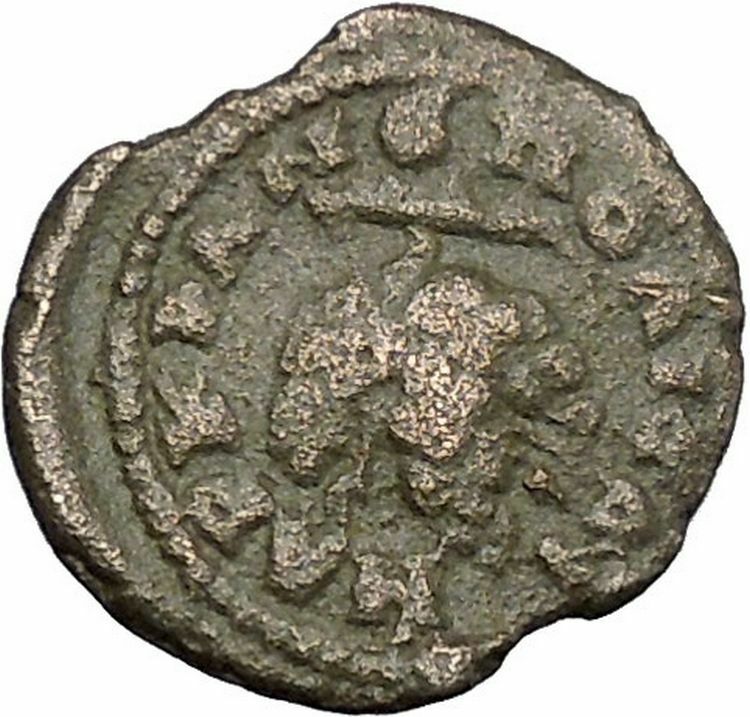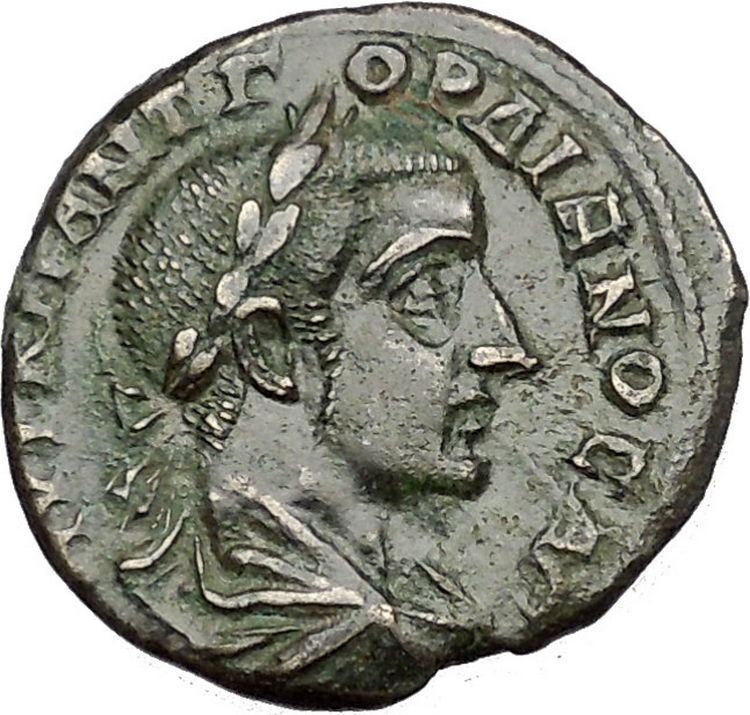|
Macrinus –
Roman Emperor: 217-218 A.D. –
Bronze 27mm (11.04 grams) of
Nicopolis ad Istrum in Moesia Inferior
under Magistrate Statilius Longinus
AVT K M ΟΠЄΛ CЄV MAKPЄINOC, Laureate head right.
VΠ CTA ΛONΓINOV NIKOΠOΛITΩN ΠPOC IC,
the “Farnese”
Hercules
standing facing, head right, resting
hand
on hip and placing left on club set on rock; lion skin beside club.
The model for this reverse type is the famed marble Farnese Hercules statue that
was discovered in the excavations of the Baths of Caracalla in 1546. It stood
for over 200 year sin the Palazzo Farnese in Rome, from whence it gained its
name, and was moved to Naples in 1787, where it is now displayed in the Museo
Archeologico Nazionale. The statue is thought to be an enlarged copy sculpted in
early 3rd Century AD by Glykon based on an original by Lysippos dating to the
4th century BC. The statue depicts Hercules at rest after completing his labors:
he is shown standing with his club, draped in the skin of the Nemean lion, set
upright on a rock, propped under his left arm supporting the weight of his
muscular frame, his head slightly nodding forward in a weary attitude, and he
holds the apples of the Hesperides behind his back in his right hand. The
sculpture was apparently well-liked by the Romans, and copies have been found in
Roman palaces and gymnasiums.
You are bidding on the exact
item pictured, provided with a Certificate of Authenticity and Lifetime
Guarantee of Authenticity.
The Farnese Hercules is an ancient sculpture, probably an enlarged
copy made in the early third century AD and signed by a certain Glykon, from an
original by Lysippos
(or one
of his

circle) that would have been made in the fourth century BC. The copy was
made for the Baths of
Caracalla
in Rome (dedicated in 216 AD),
where it was recovered in 1546.
History
The heroically-scaled Hercules
is one of the most famous sculptures of
Antiquity
, and has fixed the image of the mythic hero in the European
imagination. It quickly made its way into the collection of
Cardinal Alessandro Farnese
, grandson of
Pope Paul III.
Alessandro Farnese was well placed to form one of the greatest collections of
classical sculpture that has been assembled since Antiquity.
It stood for generations in its own room at
Palazzo Farnese, Rome
, where the hero was surrounded by frescoed depictions
of his feats by Annibale Carracci
and his studio, executed in the 1590s.
The Farnese statue was moved to Naples
in 1787 and is now displayed in the
Museo Archeologico Nazionale
.
The type was well known in Antiquity: a Hellenistic or Roman bronze
reduction, found at Foligno
is conserved in the Musée
du Louvre
; a small marble, probably Greek of the Roman period, is to be seen
in the Museum of the Ancient Agora, Athens (illustration).
The Farnese Hercules is a massive and muscular marble statue,
following a lost original
cast
in bronze
through a
method called
lost wax casting
. It depicts a weary
Hercules leaning on his
club, which has his lion-skin draped over it. He is performing one of the last
of
The Twelve Labours
, which is suggested by the
apples of
the Hesperides
he holds behind his back. This prominently-sited statue was
well liked by the
Romans
,
and copies have been found in Roman palaces and gymnasiums: another, coarser,
stood in the courtyard of Palazzo Farnese; one with the feigned (but probably
ancient) inscription “Lykippos” has stood in the court of
Palazzo Pitti,
Florence, since the sixteenth century.
Guglielmo
della Porta, the head had been recovered separately, from a well in
Trastevere, and was bought
for Farnese through the agency of della Porta, whose legs made to complete the
figure were so well regarded that when the original legs were recovered from
ongoing excavations in the Baths of Caracalla, della Porta’s were retained, on
Michelangelo‘s advice,
in part to demonstrate that modern sculptors could bear direct comparison with
the ancients. The original legs, from the
Borghese
collection, were not reunited with the sculpture until 1787.
Goethe
, in his Italian Journey, recounts his differing impressions upon
seeing the Hercules with each set of legs, marvelling at the clear superiority
of the original ones.
Hercules is caught in a rare moment of repose. Leaning on his knobby club
which is draped with the pelt of the
Nemean Lion
, he holds the apples of the
Hesperides in his right
hand, but conceals them behind his back like a baseball pitcher with a
knuckleball. Many engravings and woodcuts spread the fame of the Farnese’s
Hercules. By 1562 the find was already included in the set of engravings for
Speculum Romanae Magnificentiae (“Mirror of Rome’s Magnificence”)
and connoisseurs, artists and tourists gaped at the original, which stood in the
courtyard of the Palazzo Farnese, protected under the arcade. In 1590-91, during
his trip to Rome, Hendrik Goltzius
sketched the statue in the palazzo courtyard. Later (in
1591) Goltzius recorded the less-common rear view, in a bravura engraving (illustration,
right), which emphasizes the already exaggerated muscular form with swelling
and tapering lines that flow over the contours.
The young
Rubens
made quick sketches of the Hercules’ planes and massing. Before
photography, prints were the only way to put the image into many hands.

The Farnese Hercules, engraved by
Hendrick Goltzius
, 1591. Two onlookers give scale.
The sculpture was admired from the start, reservations about its exaggerated
musculature only surfacing in the later eighteenth century.
Napoleon remarked to
Antonio Canova that
its lack in the museum he accumulated in Paris was the most important gap in the
collection, and the sculpture was more than once crated ready for shipment to
Paris before the Napoleonic regime fled Naples.
Wealthy collectors could afford one of the numerous bronze replicas in sizes
for table-top display. A full-size marble copy that belonged to the Bourbons of
Naples is at the National Museum, Naples.
Copies of the Farnese Hercules appeared in 16th- and 18th-century gardens
throughout Europe. During construction of the
Alameda de Hercules
(1574) in Seville
, the oldest
public garden
preserved in Europe, on the cover were installed two columns
from a Roman temple, an unquestionable sign of admiration for the Roman
archaeological sites, elements of a building still preserved in the Marble
Street. On them were placed two sculptures by
Diego de Pesquera
, in 1574, of the Farnese Hercules, as founder of the city,
and of Julius Caesar
,
restorer of Híspalis. The first was a copy of the Farnese Hercules, near the
monumental size of the famous Roman marble from the
Baths of Caracalla.
At
Wilhelmshöhe
, near Kassel
,
a colossal version 8.5 m high produced by Johann Jacob Anthoni, 1713–1717, has
become the city’s mascot. André Le Nôtre
placed a full-size gilded version against the skyline at the
far end of the main vista at
Vaux-le-Vicomte. That
at
Versailles
is a copy by
Jean Cornu
, 1684–1686. In Scotland
a rare copy in lead
,
of the first half of the 18th century, is sited incongruously in the central
Highlands
, overlooking the recently restored Hercules Garden in the grounds
of Blair Castle.
Nicopolis ad Istrum was a
Roman
and Early
Byzantine
town founded by Emperor
Trajan
around
101–106, at the junction of the Iatrus (Yantra)
and the Rositsa
rivers, in memory of his victory over the
Dacians
. Its
ruins are located at the village of
Nikyup
, 20 km north of
Veliko Tarnovo
in northern
Bulgaria
.
The town reached its apogee during the reigns of Trajan,
Hadrian
, the
Antonines
and the
Severan dynasty
.

The classical town was planned according to the orthogonal system. The
network of streets, the forum surrounded by an Ionic colonnade and many
buildings, a two-nave room later turned into a basilica and other public
buildings have been uncovered. The rich architectures and sculptures show a
similarity with those of the ancient towns in Asia Minor. Nicopolis ad Istrum
had issued coins, bearing images of its own public buildings.
In
447 AD
, the town was destroyed by
Attila’s
Huns
.
Perhaps it was already abandoned before the early 400s.
In the 6th century, it was rebuilt as a powerful fortress enclosing little more
than military buildings and churches, following a very common trend for the
cities of that century in the Danube area.The largest area of the extensive ruins (21.55 hectares) of the classical
Nicopolis was not reoccupied since the fort covered only one fourth of it (5.75
hectares), in the southeastern corner.
The town became an episcopal centre during the early Byzantine period. It was
finally destroyed by the Avar invasions at the end of the 6th century. A
Bulgarian medieval settlement arose upon its ruins later (10th-14th century).
Nicopolis ad Istrum can be said to have been the birthplace of
Germanic
literary tradition. In the 4th century, the
Gothic
bishop,
missionary and translator
Ulfilas
(Wulfila)
obtained permission from Emperor
Constantius II
to immigrate with his flock of converts to Moesia and settle
near Nicopolis ad Istrum in 347-8.
There, he invented the
Gothic alphabet
and translated the
Bible
from
Greek
to
Gothic
.
Marcus Opellius Macrinus (ca. 165 – June 218) was
Roman
emperor
for fourteen months in 217 and 218. Macrinus was the first emperor
to become so without membership in the senatorial class. Macrinus was possibly
of Berber
descent.
//
Background
and career
Born in Caesarea (modern
Cherchell
,
Algeria) in the
Roman province
of
Mauretania
to an
equestrian
family, Macrinus received an education which allowed him to
ascend to the Roman political class. Over the years he earned a reputation as a
skilled lawyer. Under the emperor
Septimius Severus
he became an important bureaucrat. Severus’ successor
Caracalla
appointed him
prefect
of the
Praetorian guard
. While Macrinus likely enjoyed the trust of Caracalla, this
may have changed when, according to tradition, he was prophesied to depose and
succeed the emperor. Rumors spread regarding Macrinus’ alleged desire to take
the throne for himself. Given Caracalla’s tendency towards murdering political
opponents, Macrinus probably feared for his own safety should the emperor become
aware of this prophecy. According to Dio, Caracalla had already taken the step
of re-assigning members of Macrinus’ staff.
In the spring of 217, Caracalla was in the eastern provinces
preparing a campaign against the
Parthian Empire
. Macrinus was among his staff, as were other members of the
praetorian guard. In April, the emperor went to visit a temple of
Luna
near the
spot of the
battle of Carrhae
, accompanied only by his personal bodyguard, which
included Macrinus. Events are not clear, but it is certain that Caracalla was
murdered at some point on the trip (perhaps on
April 8
).
Caracalla’s body was brought back from the temple by his bodyguards, along with
the corpse of a fellow bodyguard. The story as told by Macrinus was that the
dead guard had killed Caracalla. By
April 11
,
Macrinus proclaimed himself emperor. Macrinus also nominated his son
Diadumenianus
Caesar
and successor and conferred upon him the name “Antoninus”, thus
connecting him with the relatively stable reigns of the
Antonine emperors
of the 2nd century.
Reign
(April 217 – June 218)
Despite his equestrian background, Macrinus was confirmed in
his new role by the
Senate
.
According to S.N. Miller, this may have been due to both his background as an
accomplished jurist and his deferential treatment of the senatorial class. He
found it necessary, however, to replace several provincial governors with men of
his own choosing. Caracalla’s mother
Julia
Domna
was initially left in peace, but when she started to conspire with the
military he ordered her to leave
Antioch
.
Being at that time in an advanced stage of breast cancer (Cassius Dio) she chose
instead to starve herself to death.
In urgent matters of foreign policy, Macrinus displayed a
tendency towards conciliation and a reluctance to engage in military conflict.
He averted trouble in the province of
Dacia
by
returning hostages that had been held by Caracalla, and he ended troubles in
Armenia
by granting that country’s throne to
Tiridates
, whose father had also been imprisoned under Caracalla. Less
easily managed was the problem of
Mesopotamia
, which had been invaded by the
Parthians
in
the wake of Caracalla’s demise. Meeting the Parthians in battle during the
summer of 217, Macrinus achieved a
costly draw
near the town of
Nisibis
and as a result was forced to enter negotiations through which was
obliged to pay the enormous
indemnity
of 200 million sesterces to the Parthian ruler
Artabanus IV
in return for peace.
Macrinus’ reluctance to engage in warfare, and his failure to
gain victory over even a historically inferior enemy such as the Parthians
caused considerable resentment among the soldiers. This was compounded by the
rolling back of the privileges they had enjoyed under Caracalla and the
introduction of a pay system by which recruits received less than veterans.
After only a short while, the legions were searching for a rival emperor.
At a high point of his popularity monuments were built to
revere Macrinus. The grand
tetrastyle
Capitoline Temple
, in
Volubilis
was erected to honour Emperor Macrinus in 217 AD.
His popularity also suffered in Rome. Not only had the new
emperor failed to visit the city after taking power, but a late-summer
thunderstorm caused widespread fires and flooding, and Macrinus’ appointee as
urban prefect proved unable to repair the damage to the satisfaction of the
populace and had to be replaced.
Downfall
This discontent was fostered by the surviving members of the
Severan dynasty
, headed by
Julia
Maesa
(Caracalla’s aunt) and her daughters
Julia Soaemias
and
Julia Mamaea
. Having been evicted from the imperial palace and ordered to
return home by Macrinus, the Severan women plotted from their home near
Emesa
in
Syria
to place another Severan on the imperial throne. They used their
hereditary influence over the cult of
sun-deity
Elagabalus (the Latinised form of
El-Gabal
) to proclaim Soaemias’ son
Elagabalus
(named for his family’s patron deity) as the true successor to Caracalla. The
rumor was spread, with the assistance of the Severan women, that Elagabalus was
in fact Caracalla’s illegitimate son, and thus the child of a union between
first cousins.
On
May 18
,
Elagabalus was proclaimed emperor by the
Gallica Legio III
at its camp at
Raphana
. A
force under his tutor Gannys marched on
Antioch
and
engaged a force under Macrinus on
June 8
,
218. Macrinus,
deserted by most of his soldiers, was soundly defeated in the
battle
, and fled towards Italy disguised as a courier. He was captured near
Chalcedon
and later executed in
Cappadocia
.
His son Diadumenianus, sent for safety to the Parthian court, was captured at
Zeugma
and also put to death.
Macrinus’ short reign, while important for its historical
“firsts”, was cut short due to the inability of this otherwise accomplished man
to control or satisfy the soldiery. In his death at the hands of Roman soldiers,
Macrinus reinforced the notion of the soldiers as the true brokers of power in
the third-century empire and highlighted the importance of maintaining the
support of this vital faction. His reign was followed by another seventeen years
of rule under the Severan emperors
Elagabalus
and
Severus Alexander
.
|











